Mucou - Study guides, Class notes & Summaries
Looking for the best study guides, study notes and summaries about Mucou? On this page you'll find 43 study documents about Mucou.
Page 4 out of 43 results
Sort by
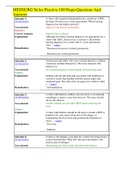
-
MEDSURG Nclex Practive 100 Prepu Questions And Answers( Complete Solution Rated A)
- Exam (elaborations) • 31 pages • 2021
-
- $17.99
- + learn more
Question 1: (see full question) A client with acquired immunodeficiency syndrome (AIDS) develops Pneumocystis carinii pneumonia. Which nursing diagnosis has the highest priority? Impaired oral mucou s membranes Impaired gas exchange Although all of these nursing diagnoses are appropriate for a client with AIDS, Impaired gas exchange is the priority nursing diagnosis for a client with P. carinii pneumonia. Airw ... (more) Pneumocystis jiroveci (carinii) pneumonia Pneumocystis carinii pneumonia Yo...
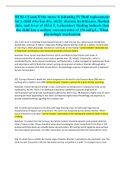
-
HESI 4 Exam/If the nurse is initiating IV fluid replacement for a child who has dry, sticky mucous membranes, flushed skin, and fever of 103.6 F. Laboratory finding indicate that the child has a sodium concentration of 156 mEq/L. What physiologic mechanis
- Exam (elaborations) • 23 pages • 2022
-
- $11.49
- + learn more
301. If the nurse is initiating IV fluid replacement for a child who has dry, sticky mucous membranes, flushed skin, and fever of 103.6 F. Laboratory finding indicate that the child has a sodium concentration of 156 mEq/L. What physiologic mechanism contributes to this finding? Correct Answer- Insensible loss of body fluids contributes to the hemoconcentration of serum solutes. Rationale: Fever causes insensible fluid loss, which contribute to fluid volume and results in hemoconcentration o...
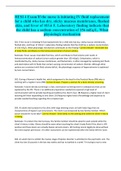
-
HESI 4 Exam/If the nurse is initiating IV fluid replacement for a child who has dry, sticky mucous membranes, flushed skin, and fever of 103.6 F. Laboratory finding indicate that the child has a sodium concentration of 156 mEq/L. What physiologic mechanis
- Exam (elaborations) • 23 pages • 2022
-
- $12.49
- + learn more
301. If the nurse is initiating IV fluid replacement for a child who has dry, sticky mucous membranes, flushed skin, and fever of 103.6 F. Laboratory finding indicate that the child has a sodium concentration of 156 mEq/L. What physiologic mechanism contributes to this finding? Correct Answer- Insensible loss of body fluids contributes to the hemoconcentration of serum solutes. Rationale: Fever causes insensible fluid loss, which contribute to fluid volume and results in hemoconcentration o...
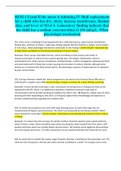
-
HESI 4 Exam/If the nurse is initiating IV fluid replacement for a child who has dry, sticky mucous membranes, flushed skin, and fever of 103.6 F. Laboratory finding indicate that the child has a sodium concentration of 156 mEq/L. What physiologic mechanis
- Exam (elaborations) • 23 pages • 2022
-
- $12.49
- + learn more
301. If the nurse is initiating IV fluid replacement for a child who has dry, sticky mucous membranes, flushed skin, and fever of 103.6 F. Laboratory finding indicate that the child has a sodium concentration of 156 mEq/L. What physiologic mechanism contributes to this finding? Correct Answer- Insensible loss of body fluids contributes to the hemoconcentration of serum solutes. Rationale: Fever causes insensible fluid loss, which contribute to fluid volume and results in hemoconcentration o...
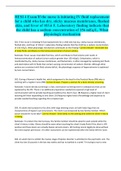
-
HESI 4 Exam/If the nurse is initiating IV fluid replacement for a child who has dry, sticky mucous membranes, flushed skin, and fever of 103.6 F. Laboratory finding indicate that the child has a sodium concentration of 156 mEq/L. What physiologic mechanis
- Exam (elaborations) • 23 pages • 2022
-
- $8.49
- + learn more
301. If the nurse is initiating IV fluid replacement for a child who has dry, sticky mucous membranes, flushed skin, and fever of 103.6 F. Laboratory finding indicate that the child has a sodium concentration of 156 mEq/L. What physiologic mechanism contributes to this finding? Correct Answer- Insensible loss of body fluids contributes to the hemoconcentration of serum solutes. Rationale: Fever causes insensible fluid loss, which contribute to fluid volume and results in hemoconcentration o...
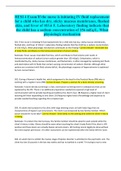
-
HESI 4 Exam/If the nurse is initiating IV fluid replacement for a child who has dry, sticky mucous membranes, flushed skin, and fever of 103.6 F. Laboratory finding indicate that the child has a sodium concentration of 156 mEq/L. What physiologic mechanis
- Exam (elaborations) • 23 pages • 2022
-
- $12.49
- + learn more
301. If the nurse is initiating IV fluid replacement for a child who has dry, sticky mucous membranes, flushed skin, and fever of 103.6 F. Laboratory finding indicate that the child has a sodium concentration of 156 mEq/L. What physiologic mechanism contributes to this finding? Correct Answer- Insensible loss of body fluids contributes to the hemoconcentration of serum solutes. Rationale: Fever causes insensible fluid loss, which contribute to fluid volume and results in hemoconcentration o...
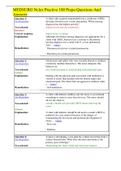
-
MEDSURG Nclex Practive 100 Prepu Questions And Answers__ Complete Solution__ Rated A+
- Exam (elaborations) • 31 pages • 2022
-
- $11.99
- + learn more
Question 1: (see full question) A client with acquired immunodeficiency syndrome (AIDS) develops Pneumocystis carinii pneumonia. Which nursing diagnosis has the highest priority? Impaired oral mucou s membranes Impaired gas exchange Although all of these nursing diagnoses are appropriate for a client with AIDS, Impaired gas exchange is the priority nursing diagnosis for a client with P. carinii pneumonia. Airw ... (more) Pneumocystis jiroveci (carinii) pneumonia Pneumocystis carinii pneumonia Yo...
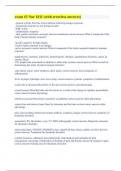
-
exam #3 Nur 1011 (with errorless answers)
- Exam (elaborations) • 6 pages • 2023
- Available in package deal
-
- $8.99
- + learn more
- present at birth; first line of host defense following antigen exposure. - nonspecific response to any foreign invader -WBC action - inflammatory response - skin, gastric secretions, enzymes, mucous membranes correct answers What is composed of the bodys natural immune response? -specific against a foreign antigen -result of prior exposure to an antigen -active or passive correct answers What is composed of the bodys acquired (adaptive) immune response? health history, nutrition, ...
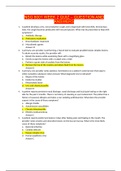
-
NSG 6001 WEEK 2 QUIZ – QUESTION AND ANSWERS 1. A patient develops a dry, non-productive cough and is diagnosed with bronchitis. Several days later, the cough becomes productive with mucoid sputum. What may be prescribed to help with symptoms? a. Antibio
- Exam (elaborations) • 1 pages • 2021
-
- $9.09
- 1x sold
- + learn more
NSG 6001 WEEK 2 QUIZ – QUESTION AND ANSWERS 1. A patient develops a dry, non-productive cough and is diagnosed with bronchitis. Several days later, the cough becomes productive with mucoid sputum. What may be prescribed to help with symptoms? a. Antibiotic therapy b. Antitussive medication c. Bronchodilator treatment d. Mucokinetic agents Answer: B 2. A primary care provider is performing a

-
Pharmacology and IV Paramedic ( updated file )
- Exam (elaborations) • 78 pages • 2021
-
- $15.49
- + learn more
11/5/2013 1 Pharmacology and IV/IO/IM/SQ History of Pharmacology • Traced back to 3rd or 4th century BC – Clay tablets record prescriptions • Earliest book – Chinese book in the 1st Century AD titled The Divine Farmer’s Herb-Root Classic • Ancient Greeks – Herbal remedies and which plants cure what ailments – Later books written were the basis of medieval medicinal manuals – Claudius Galen- father of pharmacy • Blood letting, bile disruption new blood History...

How much did you already spend on Stuvia? Imagine there are plenty more of you out there paying for study notes, but this time YOU are the seller. Ka-ching! Discover all about earning on Stuvia


